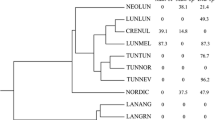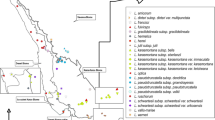Abstract
Bidens alba, B. subalternans, and B. pilosa form a complex group based on their morphological similarities. Bidens pilosa L. and B. subalternans DC. are herbs with a wide distribution in agricultural and disturbed areas. Bidens alba (L.) DC. varies in size from herb to subshrub and has a coastal distribution. Enzyme electrophoresis was used to evaluate genetic diversity in 12 populations of Bidens. All but three loci (Lap-1, Est, and Got) were monomorphic. Est-1 and Got were polymorphic only in B. alba. Lap-1 was polymorphic only in B. pilosa and B. subalternans. The estimates of genetic variability were low for all three taxa and all of the populations studied. Genetic diversity varied from 0.01 to 0.03. Mean genetic identities were high among populations of each species (0.99 for B. alba and 1.00 for B. pilosa and B. subalternans) and among the three species (1.00). Bidens pilosa and B. subalternans could be considered a single species if the taxonomy of the group were based solely on isozyme data.
Similar content being viewed by others
References
Alfenas, A. C., Peters, I., Bruce, W., and Passador, G. C. (1991). Eletroforese de Proteinas e Isoenzimas de Fungos e Essências Florestais. SIF, Viçosa.
Anderson, J. K., and Warwick, S. I. (1999). Chromosome number evolution in the tribe Brassicaceae (Brassicaceae): Evidence from isozyme number. Plant Syst. Evol. 215:255–285.
Antonovics, J. (1968). Evolution in closely adjacent plant populations: 5, Evolution in self-fertility. Heredity 23:219–218.
Baker, H. G. (1965). Characteristics and modes of origin of weeds. In Baker, H. G., and Stebbins, G. L. (eds.), The Genetics of Colonizing Species. Wiley, New York, pp. 73–98.
Ballard, R. (1986). Bidens pilosa complex (Asteraceae) in North and Central America. Am. J. Bot. 73:1452–1465.
Barret, S. C. H. (1992). Genetics of weed invasions. In Jain, S. K., and Botsford, L. W. (eds.), Applied Population Biology, Kluwer Academic Publishers, Netherlands, pp. 91–119.
Barret, S. C. H., Morgan, M. T., and Husband, B. C. (1989). The dissolution of a complex genetic polymorphism: The evolution of self-fertilization in tristilous Eichhornia paniculata (Pontederiaceae). Evolution 43:1398–1416.
Brune, W., Alfenas, A. C., and Junghans, T. G. (1998). Identificações específicas de enzimas em géis. In Alfenas, A. C. (ed.), Eletroforese de isoenzimas e proteínas afins. Fundamentos e aplicações em plantas e microorganismos. Editora da Universidade Federal de Viçosa, pp. 201–317.
Cabrera, A. L. (1974). Flora ilustrada de Entre-Rios (Argentina). Colección Cientifíca del INTA, Buenos Aires 6:106–554.
Clayton, J., and Tretiak, D. (1972). Amine-citrate buffers for pH control in starch gel electrophoresis. J. Fisheries Res. Board Canada 29:1169–1172.
Corrias, B., Rossi, W., Arduino, P., Cianchi, R., and Bullini, L. (1991). Orchis longicornu Poiret in Sardinia: Genetic, morphological, and chorological data. Webbia 45:71–101.
Crawford, D. J. (1983). Phylogenetic and systematic inferences from electrophoretic studies. In Tanksley, S. O., and Orton, T. J. (eds.), Isozymes in Plant Genettcs and Breeding, part A, Elsevier, Amsterdam, pp. 257–287.
Crawford, D. J. (1990). Plant Molecular Systematics: Macromolecular Approaches, Wiley, New York.
Ganders, F. R., Berbee, M., and Pirseydi, M. (2000). ITS base sequence phylogeny in Bidens (Asteraceae): Evidence for the continental relatives of Hawaiian and Marquesan Bidens. Syst. Bot. 25:122–133.
Gottlieb, L. D. (1977). Electrophoretic evidence and plant systematics. Ann. Mo. Bot. Gard. 64:161–180.
Goudet, J. (2001). FSTAT: A program to estimate and test gene diversities and fixation indices (version 2.9.3).
Grombone-Guaratini, M. T., Solferini, V. N., and Semir, J. (2004). Reproductive biology in three species of Bidens L. (Asteraceae). Sci. Agric. 61:185–189.
Grombone-Guaratini, M. T., Silva-Brandao, K. L., Solferini, V. N., Semir, J., and Trigo, J. R. (2005). Sesquiterpene and polyacetylene profile of the Bidens pilosa complex (Asteraceae: Heliantheae) from southeast of Brazil. Biochem. Syst. Ecol. 33:479–486.
Hamrick, J. L., and Godt, M. J. W. (1990). Allozyme diversity in plant species. In Brown, H. D., Clegg, M. T., Kahler, A. L., and Weir B. S. (eds.), Plant Population Genetics, Breeding, and Genetic Resources, Sinauer, Sunderland, pp. 43–63.
Hamrick, J. L., Linhart, Y. B., and Mitton, J. B. (1979). Relationships between life history characteristics and electrophoretically detectable genetic variation in plants. Annu. Rev. Ecol. Syst. 10:173–200.
Haufler, C. H. (1987). Electrophoresis is modifying our concepts of evolution in homosporous pteridophytes. Am. J. Bot. 74:953–966.
Hedrick, P. W., Ginevan, M. E., and Ewing, E. P. (1976). Genetic polymorphism in heterogeneous environments. Annu. Rev. Ecol. Syst. 7:1–32.
Helenurm, K., and Ganders, F. (1985). Adaptive radiation and genetic differentiation in Hawaiian Bidens. Evolution 39:753–765.
Jansen, R. K. T., Stuessy, F., Diaz-Piedrahita, S., and Funk, V. A. (1984). Recuentes cromosómicos en compositae de Colombia. Caldasia 14:7–20.
Leitão Filho, H. F., Aranha, C., and Bacchi, O. (1975). Plantas Invasoras de Culturas no Estado de São Paulo, HUCITEC, São Paulo.
Loveless, M. D., and Hamrick, J. L. (1984). Ecological determinants of genetic structure in plant populations. Annu. Rev. Ecol. Syst. 15:5–95.
Magenta, M. A. G. (1998). As subtribos Ambrosiinae, Galinsoginae e Coreopsidinae (Heliantheae-Asteraceae) no Estado de São Paulo. Master's dissertation, Universidade de São Paulo.
Moraes, M. D. (1997). A familia Asteraceae na planicie litoranea de Picinguaba, Municipio de Ubatuba, São Paulo. Master's dissertation, Universidade Estadual de Campinas.
Nei, M. (1978). Estimation of average heterozygosity and genetic distance from a small number of individuals. Genetics 89:583–590.
Okuno, K., Ebana, K., Voov, B., and Yoshida, H. (1998). Genetic diversity of central Asian and north Caucasian Aegilops species as revealed by RAPD markers. Gen. Res. Crop Evol. 45:389–304.
Pester, T. A., Ward, S. M., Fenwick, A. L., Westra, P., and Nissen, S. J. (2003). Genetic diversity of jointed goatgrass (Aegilops cylindrica) determined with RAPD and AFLP markers. Weed Sci. 51:287–293.
Roberts, M. L. (1983). Allozyme variation in Bidens discoidea (Compositae). Brittonia 35:239–247.
Shaw, C. R., and Prasad, R. (1970). Starch gel electrophoresis of enzymes: A compilation of recipes. Biochem. Genet. 4:297–320.
Sherff, E. E. (1937). The genus Bidens. Field Mus. Nat. Hist. Bot. Ser. 16:16–484.
Solbrig, O. T., Kyhos, D. W., Powell, M., and Raven, P. H. (1972). Chromosome numbers in Compositae, 8: Heliantheae. Am. J. Bot. 59:869–878.
Soltis, D. E., and Soltis, P. S. (1993). Molecular data and the dynamic nature of polypioidy. Rev. Plant Sci. 12:243–273.
Soltis, D. E., Haufler, C. H., Darrow, D. C., and Gastony, G. J. (1983). Starch gel electrophoresis of ferns: A compilation of grinding buffers, gel and electrode buffers, and staining schedules. Am. Fern. J. 73:9–27.
Stebbins, L. G. (1957). Self fertilization and population variability in higher plants. Am. Natur. 91:337–354.
Sun, M. (1997). Population genetic structure of yellow starthistle (Centaurea solstitialis), a colonizing weed in the western United States. Can. J. Bot. 75:1470–1478.
Sun, M., and Ganders, F. R. (1990). Outcrossing rates and allozyme variation in rayed and rayless morphs of Bidens pilosa. Heredity 64:139–143.
Volis, S., Mendlinger, S., Turuspekov, Y., and Esnazarov, U. (2002). Phenotypic and allozyme variation in Mediterranean and desert populations of wild barley, Hordeum spontaneum Koch. Evolution 56:1403–1415.
Warwick, S. I. (1990a). Genetic variation in weeds, with particular reference to Canadian agricultural weeds. In Kawano, S. (ed.), Biological approaches and evolutionary trends in plants, Academic Press, London, pp. 3–17.
Warwick, S. I. (1990b). Allozyme and life history variation in five northwardly colonizing North American weed species. Plant Syst. Evol. 169(4):1–54.
Watson, L. E., Elisens, W. J., and Estes, J. R. (1994). Genetic variation within and among populations of the Marshallia graminifolia complex (Asteraceae). Biochem. Syst. Ecol. 22:577–582.
Weir, B. S., and Cockerham, C. C. (1984). Estimating F-statistics for the- analysis of population structure. Evolution 38:1358–1370.
Author information
Authors and Affiliations
Corresponding author
Rights and permissions
About this article
Cite this article
Grombone-Guaratini, M.T., Semir, J. & Solferini, V.N. Low Allozymic Variation in the Bidens pilosa L. Complex (Asteraceae). Biochem Genet 43, 335–345 (2005). https://doi.org/10.1007/s10528-005-6774-2
Received:
Accepted:
Issue Date:
DOI: https://doi.org/10.1007/s10528-005-6774-2




